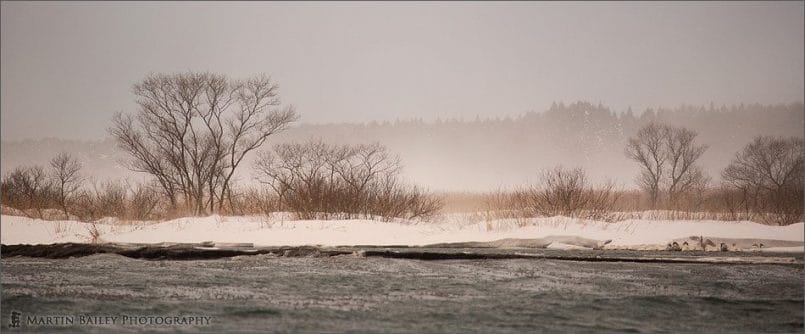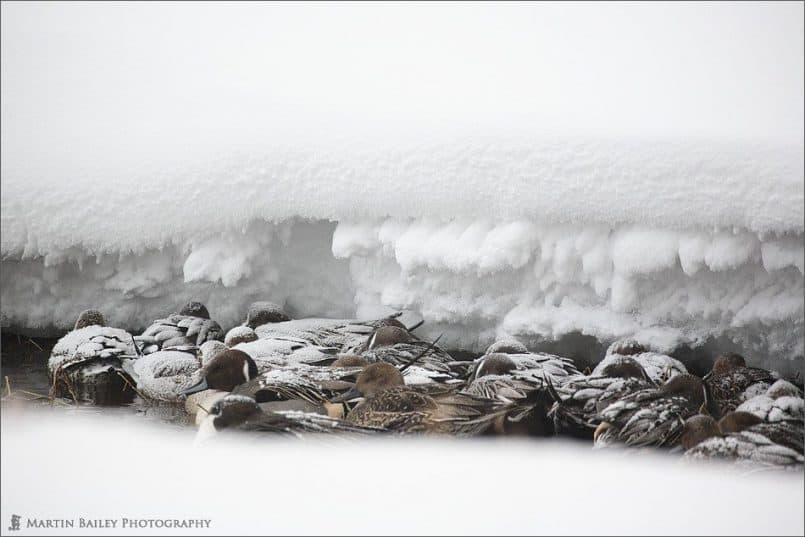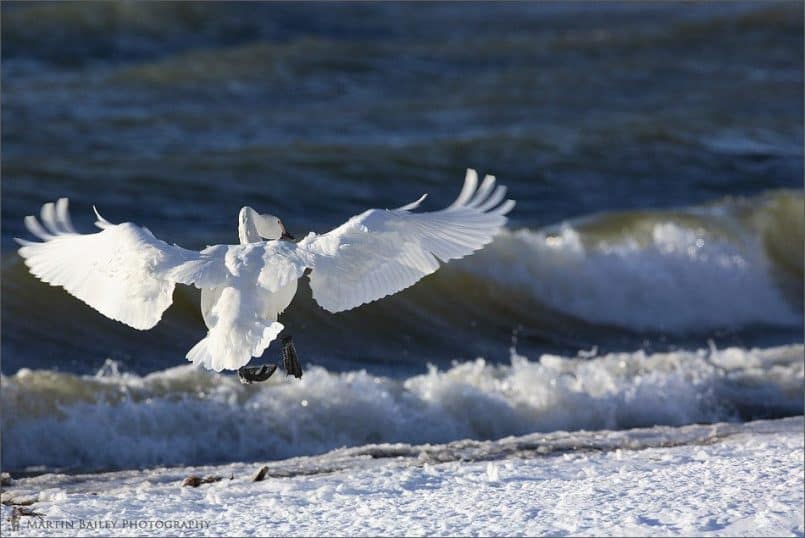Welcome to episode 18. In Episode 17 I spoke about Winter Photography, giving some tips for shooting in sub-zero conditions. After the episode was released a number of members on my Web site kindly raised a few other tips that I really should have included, so I am today going to briefly mention these, although they have already been discussed in the forum, and also I’m going to mention some other important things that I reminded myself of on Dec 28th while shooting in sub-zero conditions at the Inawashiro Lake in Fukushima Prefecture here in Japan.
Firstly, John Briggs from Maryland, USA, login name phr0ze, reminded me that I hadn’t mentioned gloves. Thanks John for taking the time to remind me. Of course, you definitely need gloves in cold conditions, let alone sub-zero conditions. I actually use two pairs of gloves in very cold conditions. What I call my under-gloves, are a relatively thin, pair of thermal gloves with fine rubber mesh kind of crisscrossing on the palm and the grip side of the fingers. They are called Windstopper and made by Taubert. I can’t find a link to these gloves for you, but I can recommend them if you come across them in your local outdoor shop. The fact that they are quite thin means that I can operate my camera while wearing them. Changing the aperture, pressing buttons and releasing the shutter are no problem at all. I can even change my memory card with these gloves on at a push.
The second pair, that I call my over-gloves are a very large pair of down mittens made by a French company call Valandré. I found a link to these gloves on an online store, so I’ll include it in the show notes. I don’t know how long the link will stay live though. Also, I have never bought anything from this online store, so I don’t know any thing about it. I use these mittens on top of my Taubert gloves when I’m standing around waiting for something to happen in really cold conditions. They can be taken off in seconds when the action starts, and when time allows I prefer to take a few more seconds to put them in my pocket before continuing to shoot. I have a bad tendency to put things under my arm while shooting then forget about it and walk away, allowing what ever it was to drop to the floor, so I like to put things away before continuing to shoot.
Another member, Keith Guthrie from London, UK, login name Keith, ask if I had any advice on changing lenses in cold conditions. I do try to keep lens changes down to a minimum, but if I have to do it, I make sure that I turn my back to the snow if it is actually snowing. Another problem here is if you have a thermal jacket on the camera you’ll maybe have to take the jacket off before or during the lens change. This really depends on the size of the lens though. This can add to the time to change the lenses too, and if you’re doing nature photography, say shooting birds or other animals, by the time you get the lens changed, the reason for changing it might be over.
In these conditions I usually keep a second camera with me with a different lens on. For example, when shooting Cranes in Hokkaido, I took my old film camera, a Canon EOS 100, loaded with Fuji Provia, and a 28-135mm lens. Now I have the 5D and the 20D, so I’ll use the 20D as a second camera, probably with the 24-105mm lens mounted. This way, if the birds fly close by or overhead, you can quickly grab the other camera and snap a few shots off.
Also following on from last week’s episode, I’d like to briefly show you a few shots made on Dec 28, as the conditions here were also pretty cold. The thermometer in my car said it was minus 5 degrees Celsius, or 23 Fahrenheit. But to get these shots I was standing of the shore of the Inawashiro Lake in Fukushima Prefecture, in the snow, with a wind blowing that was strong enough to cause waves on the Lake, so it felt much colder, probably around minus 10 Celsius or 14 degrees Fahrenheit. Also, I’ll interject a couple more tips that I reminded myself of on this shoot.
Anyway, the first photo is number 809. If you are new to the Martin Bailey Photography Podcast, you can see the shots in a number of ways. If you are listening on an iPod, you will only be able to see this first shot, until Apple bring out a tool to allow me to create Enhanced Podcasts that is. You can see this and all images in iTunes if you are listening via iTunes on a Mac or PC. Just click the thumbnail in the bottom left of the iTunes window and move forwards through the shots with the little arrows above the thumbnail, clicking on the thumbnail again to open each image. The third way is to view the images on my Web site at martinbaileyphotography.com. You can either enter the number, in this case 809, into the field under the Podcasts section on the top page or on the main Podcasts page, or jump to the main Podcasts page and locate this episode in the list. You can then see all of the image thumbnails and click on them to view the image full size.
In this first image you’ll see an early morning scene from the Inawashiro Lake. This was shot at just after 7AM on a pre-breakfast walk on the beach in front of the hotel. I used my 100-400mm F4.5 – 5.6 L IS USM lens, at 400mm. I chose ISO 400 as there was not a lot of light around yet, and an aperture of F5.6 for 1/125 of a second. I was pushing it hand holding at this focal length for 125th of a second, but it came out really sharp. This is probably one of my favourite shots from this shoot. It is also another great example of including an accent in your shots to raise them a cut above the rest. You won’t be able to see this on an iPod, but if you look in iTunes or on my Web site you’ll see a swan spreading its wings in the right hand side of the frame. When printed out this really makes the shot. I also like the fact that the image has bands of interest. There’s the water of the lake in the foreground with a kind of sherbet ice floating on the surface. Then there’s the band of what I think is black lava before the snow, then the band of snow itself. After that there’s the line of foreground trees, then some high grass, then another line of tree in the background, all separated by layers of mist. This all for me makes this a very deep shot. I feel almost embarrassed praising my own work this much, but I really just cannot get enough of this image right now. And as us photographers basically have to be pretty egotistical in the first place to even ask others to look at our images, I’ll let this ride for now.
Something else I should note is that I have obviously cropped the top of this shot, mainly because it didn’t add anything, being just more of the same coloured sky, and also this helps to emphasize the layers in the shot that I just mentioned.
Next, let’s take a look at shot number 810. This was also taken at 400mm at F5.6, with a shutter speed of 1/125 of a second. I had to crank the ISO up to 800 though, as it was pretty dark in the swath cut through the snow by the small stream in which these poor little ducks had sheltered for the night. I couldn’t help but feel sorry for these little Pintail Ducks with the snow on their backs, all huddled together to keep warm. I had to be careful here not to scare the birds, so I settled for this shot from a relatively long distance. As I walked around even from this distance the ducks started to become unsettled, so I stepped back and walked around a long way. These guys need all the energy they can get without having to get away from me.
Now, after this hour or so walk in the cold before breakfast, I went back to my room in the hotel nearby and was conscious that I was going from a cold environment to a warm one, and was being careful as I know that condensation forms on your equipment if you take it from a very cold place to a warm place (and sometimes visa versa) if you don’t keep your equipments in an air-tight bag. I usually put all my equipment back into my camera bag before entering a building, but this morning thought I’d be OK because the hotel I stayed in last night was really cold everywhere except the room. Even the hallway to the room, where you take your shoes off, seemed pretty cold before I went outside, so I thought I’d get away with putting my camera and 100-400mm lens in there to let them gradually warm up. Not so! It was there for maybe three minutes and when I went back to check if they were OK there was condensation all over them. I quickly wiped them, put them into my equipment bag, and took them to the nice cold car outside. They seemed OK after breakfast, so I don’t think there was internal damage, but I was reminded of this rule with a bump. If you don’t have a relatively air-tight camera bag, carry some large plastic bags like dustbin liners or something and put your gear into them and tie them up before going in doors.
Moving on to the last shot I want to show you today, which is number 818, is one that I made in the afternoon, having left this spot then returned for an few hours later in the day. This was made with a 600mm F4L IS USM lens, again at ISO 400. I chose F11 for 1/500 of a second, as I wanted to ensure I had a reasonable depth of field, as the swan was flying pretty close to me. I could possibly have gone to F8, but I wanted to ensure the entire swan was in focus and I also wanted the waves on the lake to be in enough focus to make them out, although not distract too much from the swan.
Now, this brings me to the very last tip I have for you today with regards to photography in sub-zero conditions. When using a tripod on deep snow, if you don’t do anything to prevent it, the legs of the tripod will sink down into the snow, probably more than you will, as the tripod has narrow feet than yours. There are two things that you can do to prevent this. The first is to buy some wide feet for your tripod. I have some Gitzo feet for my tripod that fit onto the bottom of the tripod legs and stop them from sinking into snow and likewise for sand and other similar surfaces.
The other thing you can do is to use a larger tripod than you would need on firm ground. I usually suggest that people buy a tripod at will get the viewfinder to their eye without raising the center pole, and with the user having to crouch. If you buy a tripod that will go a foot or two above your eye level though, this will cover you for some sinking in snow or sand. If you are in the market for a tripod, another reason for getting one that is a few feet larger than you is that this, along with some small steps or a sturdy camera case, will help you to get above the height of a crowd if necessary. For example, if you are at a sporting event or show where many people may be in front of you this can be useful. You could not really use a tripod in these situations anyway, so going to the back and standing on steps or your camera case, then raising your tripod to your eye will help you to get the shot and not annoy anyone doing so.
Well, that’s it on Winter Photography for today. I want to finish with one quick mention that I have setup a Member Galleries web site for Martin Bailey Photography members to upload their own work to either simply showcase it, or to display it for discussion or critiquing by other members. I want this site to be for artistic photography only, and I have limited members to 25MG of disk space each, so that you think about what you upload. I will be monitoring uploaded images, but if you notice anything abusive or out of context, please click on the little cartoon balloon button above the image when viewed full size, and report the image to me. If I think necessary I’ll remove the image.
I should also note that I am still working on sharing the credentials between the main Martin Bailey Photography site where many of you are already members and this new Member Galleries site. I am not sure how long it will take to complete this, but for now, you will need to register afresh in the new site before you can create albums and upload photos. Please use the same username and email address as you do in martinbaileyphotography.com though, as this will help to identify you and also help when I finally link the two sites.
Finally, I’ve created a help document to help you with the BBCode needed to embed thumbnails and full sized images into forum posts. You can of course also use comments in the gallery to discuss your images, without going to the forum. The help document is in the Help and Support forum on my Web site. I’ll add a link to the show notes too. Do let me know if you have any problems or feedback on the site.
So that’s it for today. Please remember that you can send feedback on the Podcast direct to me via the contact form on my Podcast page, or via email or Private Message from the forum if you take a moment to register. Also, as more of you listeners discuss various topics in the forum things are starting to liven up significantly. If you want to discuss photography or other topics with all levels of photographers, please sign up at martinbaileyphotography.com and get involved. We have a great crowd, for which I am very grateful, and I’m sure the site will become more and more exiting as other also join in the discussions.
Speak to you again next week. Bye for now.
Show Notes
The Music in the first 28 Podcasts is copyright of William Cushman © 2005, used with kind permission.
The down mittens that I use as over-gloves that I mention in this episode are made by a French company call Valandré. I couldn’t find a link to a Web Valandré page but here is a link to the gloves in an online store: http://www.guideschoice.com/scripts/prodView.asp?idproduct=478
Subscribe in iTunes for Enhanced Podcasts delivered automatically to your computer.
Download this Podcast in MP3 format (Audio Only).






0 Comments